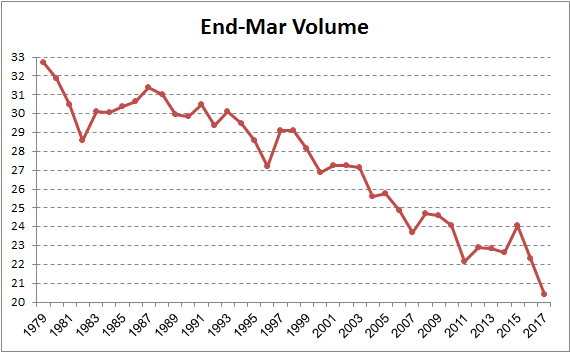Arctic
Sea Ice Volume Continues to Crater
“Facts are stubborn things; and whatever may be our wishes, our inclinations, or the dictates of our passions, they cannot alter the state of facts and evidence.” — John Adams
*****
(March sea ice volume hit a new record low in the PIOMAS measure during 2017. Image source: Oren and the Arctic Sea Ice Blog.)
6
April, 2017
This week, measurements from PIOMAS indicate that Arctic sea ice volume for the month of March hit new, all-time record lows during 2017. March 2017 volume, according to the Polar Science Center, dropped about 1,800 cubic kilometers from the previous record low set during the same month in 2011. In total, more than a third of March sea ice volume has been lost since 1979.
The Polar Science Center notes:
Arctic sea ice volume through March 2017 continued substantially below prior years. March 2017 sea ice volume was 19,600 km3 , 1800 km3 below the previous record from March in 2011. This record is in part the result of anomalously high temperatures throughout the Arctic for November through January discussed hereand here [and here]. February volume was 39% below the maximum March ice volume in 1979, 27% below the 1979-2016 mean, and more than 1.7 standard deviations below the long term trend line.
This increasingly thin ice cover should continue to grow a little more to reach a seasonal peak during the first or second week of April. And as you can see when looking at the graph below, the trend line following that peak does not paint a very optimistic picture for sea ice resiliency during the 2017 melt season.
(The rate of sea ice refreeze this year has been very slow. As a result, the trend line points toward the potential for a melt season that exceeds even the record low year of 2012. Image source: PIOMAS.)
Merely transposing the present gap between March 2017 and the last record low to the end of melt season in September would about split the difference between 2012’s record melt and a completely ice-free Arctic Ocean — leaving about 1,700 km3 sea ice remaining by September of 2017.
A more detailed meta-analysis of this rather ominous-looking trend line finds that after hitting a peak of around 20745 km3 of sea ice sometime this month, an average of 18270 km3 of this ice will tend to melt out during the spring and summer so long as the past 10 melt seasons are a reliable predictor of future results. If this happens, sea ice volume will hit a new record low of around 2,530 km3 by September — which would be about 1/3 smaller than the amount of ice remaining in the Arctic Ocean following the tremendous 2012 melt season. And a very strong melt season — similar to conditions seen in 2010 — could reduce the ice to less than 1,000 km3 which is well into the range of a near-ice-free state.
(The Arctic has never been so warm in winter as the number of freezing degree days hit a new record low during 2016-2017. For context, the less freezing degree days the Arctic Ocean sees, the closer it is to melting. Image source: Cryosphere Computing.)
Of course, April through June could see cooler conditions — which would tend to preserve more ice and tamp down the ultimate rate of loss. But the present record low sea ice volume and near record low extent sets up a situation where darker seas will absorb more sunlight and stack the odds in favor of warmer than typical conditions and higher overall rates of melt. Meanwhile, presently strong sea ice export through the Nares and Fram Straits appears to be continuing a trend of relative sea ice volume loss through early April.
(UPDATED)
Links:
Hat tip to Ryan in New England
Hat tip to Cate
Hat tip to Yvan






No comments:
Post a Comment
Note: only a member of this blog may post a comment.